Her Excellency Jo Tyndall, New Zealand’s High Commissioner shares her moving and personal connection to Singapore.
In February 2019, Her Excellency, Jo Tyndall, began her four-year posting as New Zealand’s High Commissioner to Singapore.
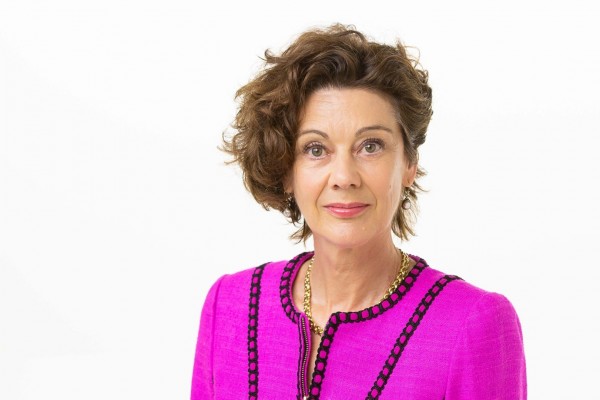
H.E Jo Tyndall, New Zealand’s High Commissioner to Singapore.
Shortly after her arrival, she reacquainted herself with a family heirloom, the diary of her great-uncle, Gordon Burt, who fled from Singapore days before the island surrendered to the Japanese in 1942.
Gordon Burt was born in 1899 in Dunedin, New Zealand. He was apprenticed to the family firm before travelling to the UK to work for Metropolitan Vickers and study engineering at the University of Liverpool. In 1925, he joined the British Arctic Expedition to Svalbard and Franz-Josef Land as chief engineer.
By 1937, he was working in Singapore as an assistant lubrication engineer for Asiatic Petroleum Company in Collyer Quay. A year later, he joined the Singapore Volunteer Armoured Car Company and married Maud Rohrbach.
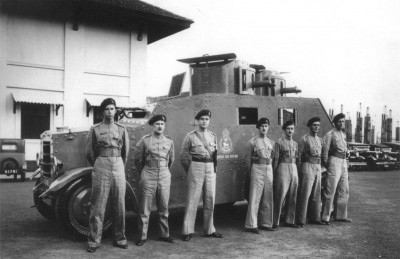
Armoured car s-165 constructed by the Singapore Harbour Board with men of the Singapore Volunteer Armoured Car Company 1933./ photo supplied
By February 1940, Gordon had risen to the rank of Mech. Sgt and in September, he became the proud father to their daughter, Jocelyn.

Announcement of wedding of Mr Gordon Burt and Miss Maud Rohrbach./ photo Straits Times 26 June 1938
A year later, his expertise in fuel and lubricants, saw him working closely with the British Navy, Army, and Air Force. His diary reveals what was happening in Singapore from December 1941 - February 1942.
The following is an extract from the journal of Gordon Burt, reprinted with permission of HE Jo Tyndall:
“From December 1941, a great deal of my time was spent at the four aerodromes, viz. Seletar, Kallang, Sembawang and Tengah. I was present during an air raid on Kallang… I was demonstrating the refuelling of a ‘Hurricane’ from drums using the Heil pumping unit, when the alarm sounded. We jumped into slit trenches and within a few minutes Kallang received one of its worst ‘blitzes,’ considerable damage being done to hangars, buildings, and grounded aircraft… By the end of January 1942, things were becoming pretty grim in Singapore…
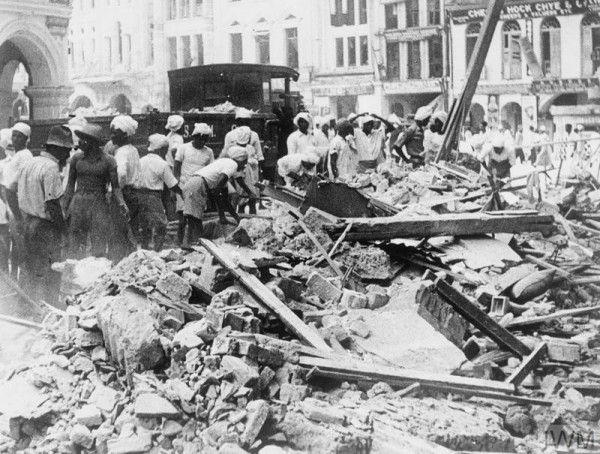
Tamil workmen clearing debris in Singapore after a Japanese air raid, 16 January 1942. / photo courtesy of Imperial War Museum London - IWM HU 57224
…The four aerodromes were in a shocking state. Practically all the available aircraft had either been destroyed on the ground or shot down, while there was hardly a building or hangar intact.
The greatest tragedy was the Naval Base. I was out there the day before the Jahore (sic) Causeway was blown up, and the whole place could only be likened to a graveyard… and walking around I saw huge stores stacked with hundreds of new torpedoes, magnetic mines, contact mines, mine-laying appliances and vast quantities of other Naval stores…my work was virtually finished and I took the opportunity of asking Singapore Management for a transfer to Sumatra or Java where my specialist knowledge and experience could be of further assistance to the War Effort.
I suggested also that I might be permitted to join the Royal Air Force as… a technical officer was required in Sumatra, particularly an officer with a knowledge of fuels, lubricants, and refuelling equipment… Early Monday morning February 9th (sic) I had occasion to visit our Aviation Depot at Kallang Aerodrome and at 7am I witnessed a number of senior R.A.F. officers board a ‘Catalina’ flying boat.
Immediately the machine was in the air, five ‘Hurricane’ fighters took off from the aerodrome--- the last of Malaya’s aircraft. From then onwards, the Japanese bombers had everything their own way, our few remaining A.A guns having no effect on the enemy plane formations…there was no point in staying in Singapore which was hourly approaching a state of chaos…on the Monday afternoon Japanese troops were at Holland Village, one mile from my home on Holland Road.
Apart from bombing there was fairly constant shelling, while fires were raging in many parts of the city. The Services and their organizations had either broken down completely or were non-existent, and it was obvious to any thinking person that Singapore would fall within a few days. It was most depressing to see hundreds of weary troops aimlessly wandering about the streets having no idea of the whereabouts of their regiments or commands--- and equally distressing were the open lorry loads of wounded and bleeding men that were continually passing my house…
On 10th February we left Singapore. Within a few minutes of our casting off there was an air raid on the docks and the noise of the bombs bursting on the wharves, in the water, and among the godowns was terrible…my emotions were poignant as I looked sadly at the city that had given me a home… a city at that moment being raped with bombs, guns and fire and all for some stupid object called “Co-prosperity.’”
Burt’s escape from Singapore was successful and he eventually ended up in Sumatra, unfortunately, as a civilian internee. He was initially imprisoned at Palembang before being transferred to Muntok internment camp. He died from malnutrition and Beriberi on 28th January 1945 and is buried in the camp’s derelict graveyard.
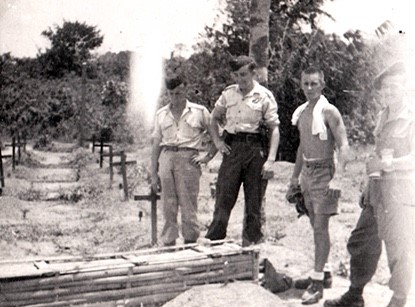
An exposed bamboo coffin at Muntok cemetery shortly after August 1945./ photo supplied
His wife, Maud, never re-married, but their only daughter, Jocelyn, had a successful career in Australia as a photographer. Jocelyn left no issue, so with her demise, Gordon’s line ended.
“Reading my great-uncle Gordon’s diary gave me a much stronger connection to Singapore,” said Tyndall. “It was poignant to have a very direct account of the horrors that people faced in 1942 and his diary made me see places in a different light. I looked at the black and white houses on Holland Road and wondered if he’d lived in one of them.
We have a defence support unit in leafy Sembawang, and our defence advisor lives in one of the old colonial houses, so it’s easy for me to imagine what Singapore could have looked like in great-uncle Gordon’s time. I’ve been moved when I’ve visited Seletar, the Battle Box and the Changi Chapel and Museum, but it’s Kranji War Cemetery that’s incredibly special to me. Not only is it the resting place of thousands of British and Commonwealth troops, its tranquillity is in such contrast to the ferocity of the battles, some of which my great-uncle witnessed.
Our commemoration service at Kranji on ANZAC Day is one of the highlights of my year, and I am delighted that it’s New Zealand’s turn to host in 2022."
New Zealand forces came to Singapore’s aid in World War Two, and we had a significant military presence in the country for twenty years from 1969 to 1989. A full battalion was based at Dieppe Barracks, so thousands of New Zealand servicemen and their families have been stationed here.
In addition to strong bi-lateral relations with Singapore, we are also part of the Five Power Defence Arrangements along with the United Kingdom, Australia, Singapore, and Malaysia.
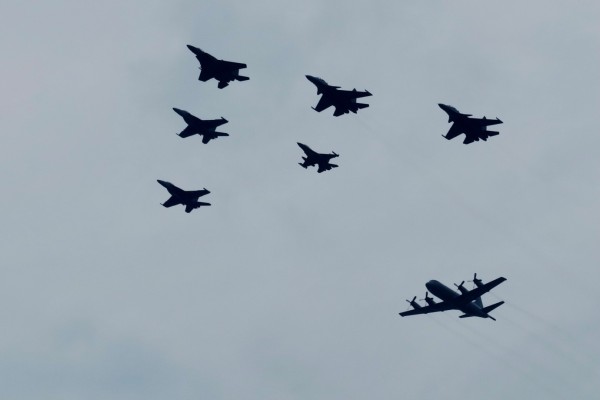
RNZAF P3-K2 flying in close formation with Singapore and Malaysian fighter aircraft/ photo supplied
"It is those service personnel, past and present, that I remember on ANZAC Day," says Tyndall. "Great-uncle Gordon was buried in a civilian graveyard, so his own contribution to the war effort will never be commemorated.
But I still remember, and on 25th April, I will honour him too, when I lay the wreath at Kranji War Cemetery on behalf of my nation."
- Asia Media Centre